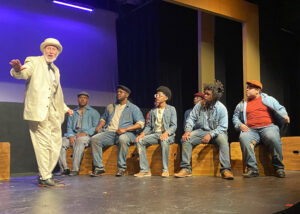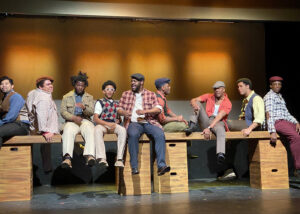The Scottsboro Boys
John Kander & Fred Ebb (Music & Lyrics); David Thompson (Book)
42nd Street Moon

Eleven Black men walk onto the stage with spirited steps carrying wooden boxes that become their seats. In the middle of their quarter-moon arc enters a tall, white man in white suit and with white hair and beard. After first announcing, “Gentleman, be seated,” he instructs in big voice, “Shake those tambourines, boys,” igniting happy-smiling faces singing “Hey, Hey, Hey” while snapping their jingling instruments on hands, knees, and raised feet. While upbeatedly parading around the stage, they assure with glad hands and bouncing heads that there will be “nothing but joy and light any night the minstrels appear.” When told that tonight they will be telling the story about the Scottsboro Boys, one pipes up, “Oh, dat’s a funny story.” Promising again that during “tonight’s night of laughter, songs, and merriment and jokes,” harmonies rise triumphantly to declare, “Everyone’s a minstrel tonight!”

The resounding, toe-tapping opening of the final collaboration by one of Broadway’s most famed duos, John Kander and Fred Ebb, receives a rousing, eye-popping, and thrilling production as 42nd Street Moon’s presents The Scottsboro Boys – a musical that is also startling, unnerving, and unsettling in both structure and content. Focusing on the horrific true story of false, rape accusations against nine, young Black men in 1931 Alabama, The Scottsboro Boys is presented as a minstrel show, a 19th-century-born form of American-born theatre popular way into the 20th century where black-faced whites in song, dance, jokes, and skits portrayed Blacks as lazy, dim-witted, happy-go-lucky to a fault, and overall foolish. As the story progresses through years of repeated, unfair trials; isolation in Southern jails, and constant threats of execution, the lone white, Mr. Interlocutor, also orchestrates his “Boys” in entertaining us with cake walks (high-kneed line dances), tunes celebrating the old South, and plenty of minstrel, glad-hands with fingers spread to the max.

The story opens as nine, young men leave Alabama in a boxcar, riding north to dreams of better times as many did during the years of Great Depression. Before they can cross the first state line, the train comes to a stop. Two white women of questionable appearance jump out of the same box car and are immediately recognized by awaiting sheriffs as local prostitutes, ready now to arrest them. Quickly, one lady of the night realizes the sure-fire way to avert jail time is to accuse the nine Black men back on the train of having raped them. Turning guns toward the confused and frightened men, the snarly, Southern-drawling sheriff spits, “They [the two women] may be white trash, but that’s good enough for me.” In 1931 Alabama, such obvious lies by white women against Black men were good enough for any jury of all white men quickly to come to a verdict of ‘guilty.’
In the minstrel-style show before us, the above incident and all the subsequent trials and tribulations for years to come against these innocent men are portrayed as an ongoing skit that teeters back and forth between Vaudeville-type antics and drama of the most sad and serious nature. Two of the minstrel cast introduced upfront as Mr. Bones and Mr. Tambo are similar to two stock characters in most minstrels by the same names who traditionally acted as ‘corner men,’ telling jokes and taking on multiple skit characters. Albert Hodge (Mr. Bones) and Anthony Rollins-Mullens (Mr. Tambo) assume with much-exaggerated gusto the parts of the story’s whites. To begin, Mr. Bones is the creepy, cruel Sherriff who drawls in tobacco-spit, drippy tones as he arrests the nine, “When it comes to justice, it’s just us” while Mr. Tambo is his sneering, snarky deputy – both intent in causing as much humiliation and pain as possible for their new, prize prisoners.
 Actors Hodge as Bones and Rollin-Mullens as Tambo excel in scraping the bottom of the barrel to find ways to play both comically and caustically a number of detestable characters. Among their roles is the accused’s drunken defensive attorney, Lawyer Johnny Walker (Tambo); a sleazy, viperous Attorney General who is as antisemitic as he is a white racist (Bones); and monstrous but also ridiculous-acting guards (both) who terrorize the youngest of the accused in a show-stopping number, “Electric Chair.”
Actors Hodge as Bones and Rollin-Mullens as Tambo excel in scraping the bottom of the barrel to find ways to play both comically and caustically a number of detestable characters. Among their roles is the accused’s drunken defensive attorney, Lawyer Johnny Walker (Tambo); a sleazy, viperous Attorney General who is as antisemitic as he is a white racist (Bones); and monstrous but also ridiculous-acting guards (both) who terrorize the youngest of the accused in a show-stopping number, “Electric Chair.”
That particular number is a great example of the show’s uneasy but telling juxtapositions of rambunctiously upbeat numbers sung and danced while portraying situations horrifying. Leroy Wright (played by a nimble, highly expressive Royal Mickens) is a teenage boy of diminutive dimensions and over-sized glasses who becomes a tossed-about jumping jack as he dances up a storm with Guards Bones and Tambo while they sing cynically to him that “not every guy gets to light up the sky [in a] in a fabulous way.” With zapping sounds, flashing lights, and sudden shakes of all bodies, the entire number of threatened doom for a frightened teen becomes one that has the look and feel of a Saturday morning cartoon’s frantic frenzy.
 The accusing Victoria Price and Ruby Bates are played with saucy swish by Jon-David Randle and Alejandro Eustaquio, respectively, with two of the accused (Ozzie Powell and Charles Weems) switching for the moment their roles, now to be dressed in skirts, scarfs, and shawls. As now two dames clearly of questionable morals, they dutifully declare themselves “loyal daughters of the solid south” and sing “Alabama Ladies” in high-pitched, purposively mocking voices, decrying their ‘deflowering’ while patting and pawing erotically the shaking, terrified men they are condemning with their lies.
The accusing Victoria Price and Ruby Bates are played with saucy swish by Jon-David Randle and Alejandro Eustaquio, respectively, with two of the accused (Ozzie Powell and Charles Weems) switching for the moment their roles, now to be dressed in skirts, scarfs, and shawls. As now two dames clearly of questionable morals, they dutifully declare themselves “loyal daughters of the solid south” and sing “Alabama Ladies” in high-pitched, purposively mocking voices, decrying their ‘deflowering’ while patting and pawing erotically the shaking, terrified men they are condemning with their lies.

One of the nine men, Haywood Patterson, is a continuing focus during the story’s unraveling of events, played and sung most impressively and distinctly by Marcus J. Page. Haywood upfront sings with sparkling anticipation of his trip north in “Commencing in Chattanooga” while later – post false accusations and during the first trial – sings with defiance his truth of “I ain’t done nothin’,” knowing that “what’s blacker, looks blacker,” “so I won’t say nothin’ ‘cause it wouldn’t help.” Marcus Page’s Haywood is strong and stoic as he stands up against increased harassment by the taunting, testy Sheriffs Bones and Tambo. He is also the one the other nine look up to as he sings a mournful “Go Back Home,” allowing against all odds to allow some glimpse hope to find space in his mesmerizing notes as he sings, “Maybe someday I’ll get lucky.” In other numbers such as “Make Friends with the Truth” and “You Can’t Do Me,” Marcus Page provides solid, soulful notes that underscore the bravery and integrity of a man who has been taught by his mama that telling truth is more important than life itself.
Brandon Jackson directs with a keen eye of finding the right balance between minstrel foolery and historical starkness. Scenes of big stage celebration fill the stage with the minstrel traditions of high-stepping, somersaulting, and mid-air kicking along with happy faces, big hands, and tambourine banging as the men feel for a short time the hope of a fair trial in “Shout.” A jolly-sounding request that is actually a command by white Mr. Interlocutor (Michael Patrick Gaffney) for his “boys” to “sing the song we love to hear” leads to one of the night’s most beautifully sung but also most hideous songs as the imprisoned men dutifully harmonize ever so sweetly “Southern Days,” a song longingly remembering the “sounds of darkies humming on a tranquil summer night.” But Kander and Ebb (along with book writer David Thompson) are careful to allow the real truths to emerge of what is right versus wrong, even in the midst of a minstrel’s mockery. To the Interlocutor’s horror, the guys end memories of “Southern Days” melodically singing of “how those sights and sounds come back to me, like my daddy hanging from a tree.”
Kimberly Valmore’s choreography is eye-popping in its exuberance and exaggerated sense of the good times that are, in the actuality of history, the worst times. Rachel Heiman’s costumes are those that demonstrate the humbleness of the innocents and the mockery of justice and truth by the accusers. Diana Lee’s music direction has well prepared this cast to sing in stellar fashion the contrasts of minstrel silly and sass pitted against the longing for home, family, freedom, and truth. The varied woodwinds of Nick DiScala, the percussion of Kristen Klehr, and the keyboard of Diana Lee invite our toes to tap to the Southern sounds of Dixie Days of the past while we also cannot help but feel guilty enjoying the similar ditties used to mock Blacks like those we see on the stage before us.
Hats deservedly go off for the remaining fine-voiced actors who so ably portray the real-life victims of Scottsboro: Jaiden Griffen as Eugene Williams, Kahlil Leneus as Andy Wright, Miles Meckling as Willie Roberson, Mercury Van Sciver as Olen Montgomery, and Dedrick Weathersby as Clarence Norris. Kudos go to the entire cast and creative team.
When the minstrel cast gathers one last time on the stage with Mr. Interlocutor, his big grinning cajole for one more cakewalk across the stage is met by their collective ignoring him and walking off with dignity. On this stage and in historical fact, the outcomes for these nine to a person were devastating, and yet their wide-spread story helped to spawn the modern Civil Rights Movement. That inspiration is illustrated by the one lone female (Elizabeth Jones) who has watched silently but always with telling expressions all the night’s proceedings from various spots on the stage. Dressed in a coat and carrying a cake box, she will end the play where she actually started it – at a bus stop in Montgomery Alabama in 1955.
Rating: 5 E
A Theatre Eddys Best Bet Production
The Scottsboro Boys continues through May 21, 2023, in production by 42nd Street Moon at the Gateway Theatre, 215 Jackson Street, San Francisco, CA. Tickets are available online at http://42ndstmoon.org .
Please note: Masks are required of all patrons in the theatre.
Photo Credits: 42nd Street Moon

Leave a Reply